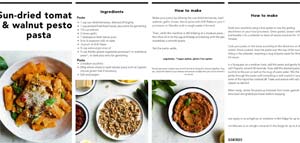Omega 3 fats are essential to our health - they support our cell membranes, brain and heart health.
To get enough of these healthy fats, we have to get them from what we eat in our diet. For vegetarians and vegans, this can be a challenge as the first recommendation for omega 3’s is oily fish.
The
omega-3s in fish eicosapentaenoic acid (EPA) and docosahexaenoic acid (DHA), are ready for the body to use. However, when it is taken from a plant-based source, the body has to convert it from alpha-linolenic acid (ALA) to the active EPA and DHA.
See larger image

In short, omega 3’s from plant-based foods need to undergo a conversion process to make them useful which can often mean you get less active EPA and DHA than you would if you were consuming omega-3’s from foods such as fish.
So if you’re getting omega-3 fats from plant-based sources, an easy way to ensure your body is getting what it needs is to eat a diverse range of
omega-3 containing foods so there’s enough for your body to utilise. These foods include chia seeds, hemp seeds, chia seed oil, flaxseed oil and walnuts.
This sun-dried tomato and walnut pesto is a great place to start as walnuts are one of the highest plant-based sources of omega 3’s.
The pesto alone can be used across a variety of recipes making it a great recipe to have up your sleeve but tossed through pasta is my personal favourite.
As the pesto is quite rich, this recipe has been lightened up with grated zucchini through the pasta making it a simple, healthy meal that is packed full of nutrition.
Sun-dried tomato & walnut pesto pasta
vegetarian, vegan option^, gluten free option
Serves 4
Ingredients
Sun-dried tomato & walnut pesto
- 1 cup sun-dried tomatoes, drained off slightly
- 1 cup packed fresh basil leaves, plus extra for garnishing
- ½ cup walnuts
- 3 cloves garlic
- 1 tablespoon fresh lemon juice
- ¼ to ½ teaspoon salt, to taste
- A pinch of chilli flakes
- ¼ cup extra-virgin olive oil
- ½ cup freshly grated vegetarian parmesan* or nutritional yeast^, to taste plus extra for garnishing
*Traditional parmesan cheese uses animal rennet to bring the cheese together. If you are a vegetarian, check the label of your cheese and ensure it states the use of non-animal enzymes or rennet
Pasta
- 2 medium zucchinis
- 250g whole-wheat or spelt tubular pasta such as rigatoni, choose gluten free if necessary
- Salt and pepper
How to make
- Make your pesto by blitzing the sun-dried tomatoes, basil leaves, walnuts, garlic cloves, lemon juice and chilli flakes in your food processor or blender until a rough paste is formed. Then, while the machine is still blitzing at a medium pace, pour the olive oil in to the jug and keep processing until the pesto resembles a smooth paste. Set the pesto aside
- Grate your zucchinis using a box grater or use the grating attachment on your food processor. Once grated, season with salt and transfer it to a colander to drain of excess moisture for 10 minutes
- Cook your pasta on the stove according to the directions on the packet. Once cooked, drain the pasta over the top of the zucchini sitting in the colander, reserving a mug of pasta water for thinning the sauce
- In a frying pan on a medium heat, add the pesto and gently fry it off until fragrant, around 30 seconds. Now add the drained pasta and zucchini to the pan as well as the mug of pasta water. Mix the pasta gently through the pesto until everything is well coated in sauce and some of the liquid has cooked off. Taste and season with salt and pepper as desired
- When ready, divide the pasta up between four bowls, garnish with extra basil and grated parmesan before enjoying
Roberta’s tips
- Store your pesto in an airtight jar or container in the fridge for up to 1 week
- Store leftovers in an airtight container in the fridge for up to 4 days
Click on image to download & print
